The topic of this article may not meet Wikipedia's general notability guideline .(October 2018) (Learn how and when to remove this template message) |
Contents
It is proposed that this article be deleted because of the following concern:
If you can address this concern by improving, copyediting, sourcing, renaming, or merging the page, please edit this page and do so. You may remove this message if you improve the article or otherwise object to deletion for any reason. Although not required, you are encouraged to explain why you object to the deletion, either in your edit summary or on the talk page. If this template is removed, do not replace it . The article may be deleted if this message remains in place for seven days, i.e., after 10:35, 21 October 2018 (UTC). Nominator: Please consider notifying the author/project: {{subst:proposed deletion notify |Raj Bhavan (Odisha)|concern=notability}} ~~~~ |
This article needs additional citations for verification .(May 2012) (Learn how and when to remove this template message) |
| Raj Bhavan (Odisha) | |
|---|---|
| ରାଜଭବନ | |
| General information | |
| Construction started | 1 January 1958 |
| Completed | 31 March 1960 |
| Owner | Government of Odisha |
| Design and construction | |
| Architect | Shri Julius Vaz |
Raj Bhavan (Odia : ରାଜଭବନ; translation: Government House)is the official residence of the Governor of Odisha located in the capital Bhubaneswar. As of September 2018 [update] the state governor of is Dr. [[Professor Ganeshi Lal].

Odia is a classical Indo-Aryan language spoken in the Indian state of Odisha.
Translation is the communication of the meaning of a source-language text by means of an equivalent target-language text. The English language draws a terminological distinction between translating and interpreting ; under this distinction, translation can begin only after the appearance of writing within a language community.

An official residence is the residence at which a nation's head of state, head of government, governor, religious leader, leaders of international organizations, or other senior figure officially resides. It may or may not be the same location where the individual conducts work-related functions or lives.
There is a history of three Raj Bhavans in Odisha: the Summer Resort at Puri, the Lal Bagh Palace at Cuttack and the main Raj Bhavan at Bhubaneswar.

Puri is a city and a Municipality in the state of Odisha in eastern India. It is the district headquarters of Puri district and is situated on the Bay of Bengal, 60 kilometres (37 mi) south of the state capital of Bhubaneswar. It is also known as Sri Jagannatha Dhama after the 12th-century Jagannatha Temple located in the city. It is one of the original Char Dham pilgrimage sites for Hindus.

Cuttack is the former capital and the second largest city in the eastern Indian state of Odisha. It is also the headquarters of the Cuttack district. The name of the city is an anglicised form of Kataka which literally means The Fort, a reference to the ancient Barabati Fort around which the city initially developed. Cuttack is also known as the Millennium City as well as the Silver City due to its history of 1000 years and famous silver filigree works. It is also considered as the judicial capital of Odisha as the Odisha High Court is located here. It is also the commercial capital of Odisha which hosts a large number of trading and business houses in and around the city. Cuttack is also famous for its Durga puja which is the most important festival of Odisha and West Bengal. Cuttack is also the birth place of Netaji Subhas Chandra Bose.



